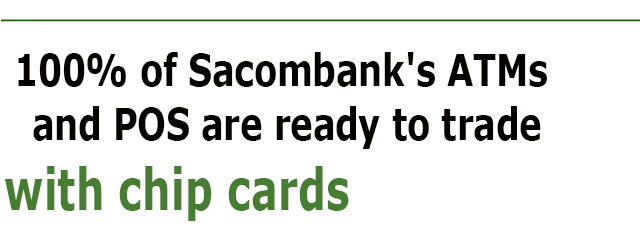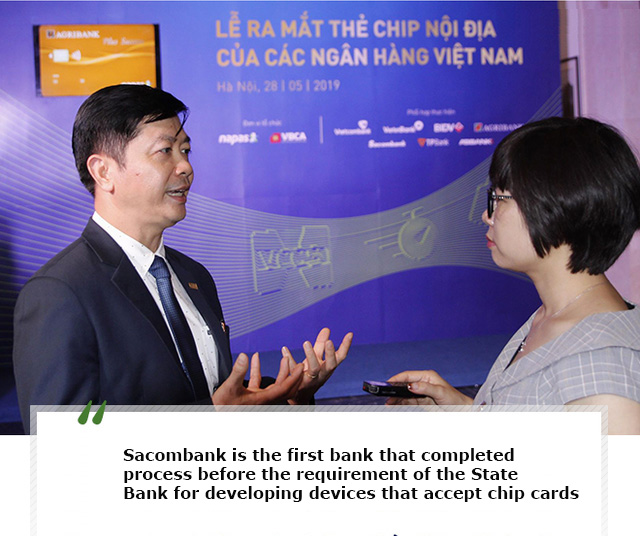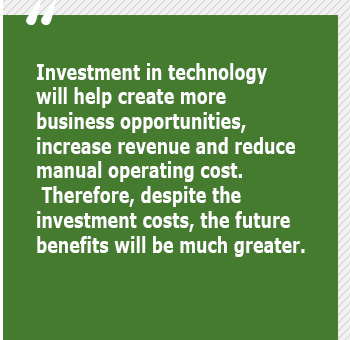We desire to be the pioneer in technology development to enhance customer experience and achieve more profit
29/05/2019
On the afternoon of May 28, Vietnam Bank Card Association cooperated with Vietnam National Payment Joint Stock Company (Napas) together with 7 banks: Vietcombank, BIDV, Agribank, VietinBank, Sacombank, ABBank and TPBank launches domestic chip card products.
The conversion from magnetic cards to domestic chip cards is a strategic goal of the State Bank, contributing to changing people's habit of using cash as well as preventing card fraud and preventing data theft by installing skimming device when customers withdraw money at ATMs.
On the side of the event, we had an interview with Mr. Nguyen Minh Tam, Deputy General Director of Sacombank - 1 of 7 pioneering banks on converting magnetic cards to chip cards as well as inventing in non-cash applications.
Sir, how many cards has Sacombank issued and when will the bank start issuing new chip cards?
We have issued more than 4 million domestic cards, including credit cards, payment cards and prepaid cards. Up to now, it can be said that Sacombank is ready to issue domestic chip cards for existing and new customers and specifically we have issued a number of chip cards for many guests who attending the launching event to immediately experience the new products.

To achieve the result of being one of the pioneering banks on magnetic card conversion to chip cards and contactless technology, how did you prepare?
Sacombank has always been a pioneer in developing new card technology. Specifically, we are one of the first banks in Vietnam to issue international chip cards in September 2010 and the first bank to issue contactless chip cards (contactless payment) in July 2017. Therefore, with the accumulated experience over the years, the implementation of the conversion of magnetic cards to domestic chip cards is not difficult.
In order to deploy the project of converting magnetic card into chip card, we have focused a lot of resources to adjust and upgrade the card issuance system and the approving card system from 12/2018. And by 5/2019, Sacombank is ready to issue domestic chip cards.
According to Circular 41 issued by the SBV, on December 31, 2019, Card payment organization must maintain at least 35% ATM that satisfied the basic standards for domestic chip cards. For Sacombank, at present, 100% of Sacombank's ATMs are ready to accept domestic chip cards. For POS equipment, we are updating and will be completed in June 2019. 100% POS accepts domestic chip cards, in which over 50% of machines support contactless feature. Therefore, it can be said that Sacombank was the first bank that completed the process before the SBV's request for chip card acceptance devices.
Does the card conversion affect the transactions of current customers, sir?
Card switching does not affect or interrupt customer card transactions. Transactions on magnetic cards during Sacombank's conversion process are still traded normally. Because when we finish manufacturing chip cards for customers, customers will come to Sacombank to receive the cards. At that time, Sacombank will activate chip cards for customers so that chip cards are ready to use, and liquidate the card that customers are using.
When using chip cards, customer transactions will be more convenient. Especially at the ATM, customers do not need to enter the 2-layer password authentication as magnetic cards.
For millions of existing cards, when is it estimated to finish the conversion process?
We expect the card conversion process will be carried out in accordance with the schedule of Circular 41/2018 stipulated by the State Bank, in particular by the end of 2019, at least 30% of domestic cards will be converted to chip card, by the end of 2020, 60% of domestic cards will be converted to chip cards and it is expected that by the end of 2021, 100% of customers will use domestic chip cards.
In order to ensure the progress of this conversion, Sacombank needs to carry out many activities in parallel such as increasing the issuance of domestic chip cards, enhancing card switching operations for existing customers.

It is known that the cost of converting this card is very expensive, can you share some details?
It is true to say that converting process is expensive. Particularly, the cost of the new chip card workpiece is 5 times higher than the magnetic card workpiece. In addition, the cost of upgrading the system for issuing and approving domestic cards is up to $100,000. As for the card acceptance network including ATM and POS, Sacombank does not cost any more because the bank has captured the trend of converting magnetic cards to chip cards, so it has prepared and invested in advanced.
Although it costs us a lot, we think that this investment is necessary and extremely important, because it ensures financial safety for customers, contributes to promoting non-cash payment activities of the Government and the State Bank.

With contactless card types, customers are not required to enter password when making payment, how secure is it?
With the new card type, we ensure higher security, but customers still need to enter the password when making payment transactions (PIN), including payment via contact chip (the chip on the front of the card), the range from the back and contactless chip (for transactions of VND1 million and above) to enhance security.
For contactless transactions with less than VND1 million, no PIN is required to ensure quick and convenient payment for customers. Smart chip integrates contactless technology to ensure full security of EMV international standards, with multiple layers of security and only works within the specified distance of payment equipment.
At the same time, the bank has also developed control risk process for trading activities which can recognize the suspicious signs, Sacombank will contact customers to ensure that the cardholder does the transaction. Customers can also actively lock the card on payment application (Sacombank Pay, Sacombank Mbanking) or by message or contact the Hotline
How will the bank encourage new card users?
In the beginning, to encourage customers to use domestic chip cards, Sacombank will implement diversified activities such as no change of issuance fees and annual fees or other fees related to the use of chips; make free conversions for high-volume customers; deploy many promotion programs to encourage customers having more card transactions; strengthen the implementation of communication activities to raise awareness about the convenience and safety of cards, especially chip cards.
For existing cardholders, we will encourage new card users by many card conversion promoting programs that come with attractive offers. At the same time, Sacombank will strengthen communication via email, SMS, telephone ... so that cardholders have more information about the benefits of new cards.
Particularly for new customers, the bank will encourage new card users by extensive communication activities on newspaper channels, websites, bank’s fanpage and by the competent consultants staff at transaction points.

With a huge investment cost, what do you expect from this new card line for banking services?
The new card line has many advantages such as enhanced security and is equipped with contactless technology to make payment quicker and more convenient. In addition, with chip technology, allowing more information to be stored on the card, will be the basis for the bank to deploy multi-utility services, data connections other than card information such as school cards, hospital card, resident card, all kinds of cards for public payment services, ... help banks to expand customer segments, as well as to bring more package services to cardholders; from there, increasing non-cash payment activities. It is expected that the conversion from technology card to chip technology will help Sacombank's domestic card increase by 30% compared to 2018.
Besides, along with the card conversion process and the development of new card products, Sacombank expects that the card will contribute 40% to the bank's profit in the next 3 years and continue to maintain the brand as the first pioneer in developing new technologies.

It is known that Sacombank is the leading bank in applying QR Code technology in payment, and is now one of the first 7 banks to convert magnetic cards to chip cards. Being the first mover in the industry will often have certain risks and difficulties, especially in terms of costs, so please share your opinions on why the bank wants to become a leader like that?
Up to now, Sacombank is the first and only bank in Vietnam to implement QR payment method which aligned with EMV standards of 5 card organizations including Visa, Mastercard, UnionPay, JCB and Napas. Although, Vietnam market is not popular with this payment method compared to China. However, we see the potential for future development, so we have invested and developed this technology quickly. It is a concrete example for the pioneering in payment technology that Sacombank has been implementing for many years.
Payment sector is very sensitive to technology and must continually change to bring the best experience to customers. It is true that the pioneer will meet certain difficulties and risks such as market reactions, need more expenses for initial investment and customer orientation to use new products and services, ... However, the pioneer will also have many advantages such as dominating the market, creating the brand image for the bank, especially and the most important is enhancing the motto of Sacombank, always focusing on customer. Getting customers’ satisfaction when experiencing the best service is a valuable reward for our efforts.
| Sacombank's strategy is modernizing technology so technology investments are expensive but necessary to implement. Investing in technology will help create more business opportunities, increase revenue and reduce manual operating costs. Therefore, although it is costly in terms of investment costs, future resources will help increase profitability. On the other hand, due to good cost planning, technology investments do not negatively affect the financial activities of the bank, whereas technology contributes to many practical benefits for Sacombank such as the trust and commitment of customers which lead to impressive growth in card sales,... |  |
In non-cash payments, which activities has Sacombank been presented, sir?
In terms of card acceptance, Sacombank deployed POS installation, QR card acceptance service, payment via Mobile NFC (Near-Field Communications) - short-range wireless technology, using magnetic induction to make the connection among devices when there is direct or close contact, electronic payment gateway, providing solutions for electronic wallets, ...
In terms of card issuance, besides issuing regular cards such as credit cards, payment cards and prepaid cards, Sacombank also deployed many other types such as co-branded cards, gift card for businesses. . We are also the first bank to implement and and to possess a relatively large contactless card acceptance network in the current market.
In addition, from 12/2018, Sacombank also launched Sacombank Pay - a financial management application with many outstanding features such as card management, QR transactions (payment, cash withdrawal, bank transfer), money transfer, online payment, mobile phone top-up, bill payment, installment payment for card transactions, automatic debt reminders, payment scheduling ... and soon will be consumer loans on Sacombank Pay. With many outstanding features, Sacombank Pay is not only for Sacombank cardholders but also for all users who download and register Sacombank Pay. If the customer is the card holders of other banks, it is possible to deposit money into Sacombank Pay via their current used card.
Especially Sacombank Pay also allows to store other bank card information in encrypted form to facilitate the subsequent deposit times. In addition, Sacombank Pay application can also be used for payment via scanning EMV standard QR code of card organizations around the world. It is very convenient for customers when traveling to popular countries by using QR payment without having to use plastic cards. Our goal is to make Sacombank Pay an application that integrates all financial solutions around our customers' daily lives and activities.

SBV Deputy Governor Nguyen Kim Anh experiences bank chip card service
Banking services are being strongly competitive by e-wallets of non-bank organizations, how do you evaluagte this competition?
E-wallet is a potential business market, so it is no longer reserved for Fintech companies. Currently the market has more than 20 electronic wallets, with the participation of not only Fintech, but also from telecommunication companies, transport technology companies, banks ... We think that many units in the different sectors participating in this new and potential market will contribute significantly to the transfer of customer behavior from using cash to non-cash payment such as e-wallets, financial applications, cards, QR, ... create a vast financial ecosystem where cash flows are strong and there will be almost no room for cash transactions.
E-wallets have the advantages of technology, investment capital, while banks have other advantages such as infrastructure, network of transaction points, network of card acceptance, payment technologies with international standards, and their sufficient existing customers base,... so it is necessary for banks to cooperate with developed e-wallets because it helps to reduce the overall cost of the whole market, bringing mutual benefits in terms of exploiting existed customer based, taking advantage of each party's technical infrastructure, ...
Sacombank has also cooperated with many e-wallets in the market through providing technical solutions to provide international standard payment tools and connecting systems so that customers of both sides can use the ecosystem.
Non-cash payments are the trend of the whole market, so how will the bank's next plan to maintain the pioneer position?
In order to promote non-cash activities, we believe that developing a payment ecosystem is necessary. Currently, the network of cards accepting payment is not really strong compared to the needs of customers, so Sacombank will focus on developing low-cost payment ecosystems such as ecosystems that accept QR and ecosystems pay daily essential activities such as invoices, airplanes ... on mobile phone to make it more convenient for users. At the same time, we also promote the connection of public payment such as SSC school card programs, medical examination cards in some big hospitals, resident cards, set up payment gateways for e-commerce services, payment of taxes, electricity, water and telecommunications...
In addition, we continue to enhance communication and promotion activities to create more incentives for customers to use non-cash payment tools.
And the bank also desires the State Bank to accelerate the process of allowing diversified payment technologies in public transportation, and other public sectors such as hospitals... to promote faster payment without cash.

